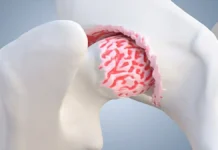The term degenerative cascade was introduced by Dr. Kirkaldy-Willis in the 1970s to explain the typical progression of degeneration of the lumbar spine. The Kikaldy-Willis’s degenerative cascade helps to understand how degenerative disc disease develops gradually.
Introduction
The notion of degenerative cascade, pioneered by Dr. Murray Kirkaldy-Willis in the 1970s, has profoundly influenced the understanding of the characteristic evolution of degeneration of the lumbar spine. This eminent Canadian orthopedist and neurosurgeon, born in 1927 and died in 2006, left a significant legacy in the field of degenerative spinal pathology.
The degenerative cascade, a term inseparable from his work, offers essential insight into the way in which degenerative disc disease gradually unfolds over time. Dr. Kirkaldy-Willis has dedicated his career to exploring the mechanisms underlying spinal degeneration, providing crucial keys for medical practitioners and researchers.
His concept of degenerative cascade can be envisioned as a complex sequence of changes in the spine, primarily in the intervertebral discs. Initiating this process, dehydration of the intervertebral discs occurs with age, leading to a loss of flexibility and resilience. This phenomenon predisposes to annular failure, where weakening of the annulus fibrosus can lead to cracks and ruptures, accentuating the vulnerability of the structure.
In response to this degeneration, the body may develop osteophytes, bony growths, in an attempt to stabilize the spine. However, this adaptive response can sometimes result in compression of surrounding neural structures, introducing an additional element of complexity and risk.
As the degenerative cascade progresses, it can progress to osteoarthritis, characterized by wear and tear of the articular cartilage at the joint facets of the vertebrae. This process contributes to pain and loss of mobility, highlighting the debilitating impact of spinal degeneration on individuals’ quality of life.
As it reaches advanced stages, the degenerative cascade can lead to spinal stenosis, a narrowing of the spinal canal that puts pressure on the spinal cord and nerve roots. This phenomenon, often synonymous with more serious symptoms, highlights the crucial importance of understanding and treating early warning signs of spinal degeneration.
Dr. Kirkaldy-Willis’ contributions have lastingly influenced treatment approaches to spinal disorders by shedding light on the progressive nature of spinal degeneration. However, it is essential to recognize that the degenerative cascade remains a theoretical concept, sometimes sparking debate in the medical community over certain aspects of its interpretation. Despite this, it continues to guide research and clinical practice, providing an essential basis for understanding and treating pathologies linked to spinal degeneration.
Degenerative cascade
The degenerative cascade, according to the concepts of Dr. Kirkaldy-Willis, describes the process of progressive degeneration of the spine, particularly at the level of the intervertebral discs. Here is a general description of the degenerative cascade:
- Dehydration of the intervertebral discs: With age, the intervertebral discs, which are structures located between the vertebrae, tend to lose water, leading to dehydration. This can lead to a loss of flexibility and resilience.
- Annular rupture: Dehydration can weaken the annulus fibrosus surrounding the gelatinous core of the intervertebral disc, eventually leading to ruptures or cracks in this structure.
- Osteophyte Formation: In response to degeneration, the body may develop osteophytes, bony growths, in an attempt to stabilize the spine. However, these osteophytes can sometimes compress surrounding nerve structures.
- Osteoarthritis: Continued degeneration can lead to osteoarthritis, wear and tear of the articular cartilage at the level of the articular facets of the vertebrae. This can contribute to pain and loss of mobility.
- Spinal Stenosis: The degenerative cascade can eventually lead to spinal stenosis, a narrowing of the spinal canal, putting pressure on the spinal cord and nerve roots.
Dr. Kirkaldy-Willis’ work has contributed to a better understanding of degenerative processes in the spine and has influenced treatment approaches for various spinal disorders. It should be noted that the degenerative cascade is a theoretical concept which, although widely accepted in the field of orthopedic medicine, can also generate debate on certain specific aspects of its interpretation.

Spinal discs required a regular supply of nutrients and oxygen to withstand the stresses of daily stress and repair themselves.
This process is conceptualized in terms of a three-joint complex consisting of the intervertebral disc and two zygoapophyseal joints that constitute a functional spinal unit, the smallest anatomical unit of the spine that demonstrates its basic functional characteristics.

Spinal degeneration involves a three-phase process
Dr. Murray Kirkaldy-Willis postulated that spinal degeneration involves a three-phase process, often conceptualized as the dysfunction, instability, and stabilization phases. Here is a brief explanation of each phase:
- Dysfunction:
- Description: This phase is characterized by an alteration of the normal function of the intervertebral disc.
- Possible causes: It can be triggered by factors such as repetitive strain injuries, poor posture, excessive strain, or other forms of mechanical stress.
- Manifestations: During this phase, there may be changes in the composition of the disc, microtears in the annulus fibrosus, and a loss of the disc’s ability to absorb shock.
- Instability:
- Description: The instability phase occurs when the supporting structures of the disc, including ligaments and facet joints, are affected, leading to increased mobility or instability.
- Consequences: Instability can lead to abnormal movement between vertebrae, putting more stress on surrounding structures.
- Body Response: In response to this instability, the body may develop osteophytes (bony growths) to attempt to stabilize the spine.
- Stabilisation :
- Description: During this phase, the body attempts to stabilize the spine by forming bony bridges, such as osteophytes, to restrict mobility and strengthen the area.
- Complications: However, this attempt at stabilization can sometimes result in complications, such as compression of surrounding nerve structures.
- Symptoms: Symptoms associated with this phase may include the formation of calcium deposits and possible fusion of adjacent vertebrae.
It is important to note that this three-phase conceptualization is a theoretical approach to understanding the progression of spinal degeneration according to the work of Dr. Kirkaldy-Willis. The specific details may vary from individual to individual, and other factors may also influence the degenerative process of the spine. Healthcare professionals use these concepts to guide the evaluation and treatment of spinal disorders.
Questionnaire on the Degenerative Cascade and the Work of Dr. Kirkaldy-Willis
Questionnaire 1
- What is Dr. Murray Kirkaldy-Willis’ area of expertise?
- a. Cardiology
- b. Neurology
- c. Orthopedics and Neurosurgery
- d. Gastroenterology
- e. Dermatology
- How did Dr. Kirkaldy-Willis contribute to the understanding of spinal degeneration?
- a. By artistic works
- b. Through research in astronomy
- c. For his contributions in the field of degenerative pathology of the spine
- d. Through studies on infectious diseases
- e. Through discoveries in genetics
- What is the initial phenomenon of the degenerative cascade according to Dr. Kirkaldy-Willis?
- a. Annular rupture
- b. Formation of osteophytes
- c. Dehydration of the intervertebral discs
- d. Osteoarthritis
- e. Spinal stenosis
- What process accompanies dehydration of intervertebral discs?
- a. Compression of nerve structures
- b. Formation of osteophytes
- c. Loss of flexibility and resilience
- d. Annular rupture
- e. Fusion of adjacent vertebrae
- Why does the body develop osteophytes in response to degeneration?
- a. To increase mobility
- b. To compress nerve structures
- c. To strengthen the region
- d. To induce osteoarthritis
- e. To stimulate the growth of the vertebrae
- What is osteoarthritis in the context of the degenerative cascade?
- a. Loss of mobility
- b. Compression of nerve structures
- c. Wear of articular cartilage
- d. Dehydration of the intervertebral discs
- e. Formation of calcium deposits
- What can the degenerative cascade lead to in advanced stages?
- a. Spinal dysfunction
- b. Spinal instability
- c. Compression of nerve structures
- d. All of the above
- e. None of the above
- What is the phase where the body tries to stabilize the spine by forming osteophytes?
- a. Dysfunction
- b. Instability
- c. Stabilization
- d. Annular rupture
- e. Osteoarthritis
- What is Dr. Kirkaldy-Willis’s proposed phase conceptualization of spinal degeneration?
- a. Growth, maturation, and senescence phase
- b. Formation, degradation, and regeneration phase
- c. Dysfunction, instability, and stabilization phase
- d. Inflammation, healing, and recovery phase e. Adaptation, resistance, and exhaustion phase
Answers:
- c
- c
- c
- c
- c
- c
- d
- c
- c
Questionnaire 2
- What is the consequence of annular rupture in the degenerative cascade?
- How does Dr. Kirkaldy-Willis characterize the instability phase in spinal degeneration?
- a. Increased mobility and osteophytes
- b. Abnormal movement between the vertebrae and microtraumas
- c. Formation of calcium deposits and nerve compression
- d. Fusion of vertebrae and wear of cartilage
- e. Dehydration of discs and loss of flexibility
- What role do osteophytes play in the degenerative cascade?
- a. Increase mobility
- b. Stabilize the spine
- c. Induce osteoarthritis
- d. Compress nerve structures
- e. All of the above
- What is the phase characterized by microtears in the annulus fibrosus and impaired intervertebral disc function?
- a. Dysfunction
- b. Instability
- c. Stabilization
- d. Formation of osteophytes
- e. Annular rupture
- What stage of spinal degeneration can lead to the formation of calcium deposits and possible fusion of adjacent vertebrae?
- a. Dysfunction
- b. Instability
- c. Stabilization
- d. Formation of osteophytes
- e. Osteoarthritis
- What is the process that requires a regular supply of nutrients and oxygen to withstand the stresses of daily stresses and repair itself?
- a. Annular rupture
- b. Degenerative cascade
- c. Formation of osteophytes
- d. Osteoarthritis
- e. Three-joint complexes
- What is the role of zygoapophyseal structures in the process of spinal degeneration according to Dr. Kirkaldy-Willis?
- a. Spinal stabilization
- b. Compression of nerve structures
- c. Dehydration of discs
- d. Formation of osteophytes
- e. Fusion of adjacent vertebrae
- What does Dr. Kirkaldy-Willis postulate as the phases of spinal degeneration?
- a. Growth, maturation, and senescence phase
- b. Formation, degradation, and regeneration phase
- c. Dysfunction, instability, and stabilization phase
- d. Inflammation, healing, and recovery phase
- e. Adaptation, resistance, and exhaustion phase
- What characterizes the instability phase in the degenerative cascade?
- a. Compression of nerve structures
- b. Fusion of adjacent vertebrae
- c. Increased mobility between the vertebrae
- d. Cartilage wear
- e. Formation of calcium deposits
- What is the phase where the body tries to stabilize the spine by forming bony bridges?
- a. Dysfunction
- b. Instability
- c. Stabilization
- d. Annular rupture
- e. Osteoarthritis
Answers:
- b
- b
- e
- a
- c
- e
- a
- c
- c
- c
Questionnaire 3
True or False Quiz on the Degenerative Cascade and the Work of Dr. Kirkaldy-Willis
- The degenerative cascade was introduced by Dr. Kirkaldy-Willis in the 1980s.
- True / False
- Dr. Kirkaldy-Willis was a specialist in dermatology.
- True / False
- Dehydration of the intervertebral discs is a phenomenon linked to rejuvenation.
- True / False
- Annular rupture in the degenerative cascade can lead to compression of nerve structures.
- True / False
- Osteophytes are bony growths formed to increase mobility of the spine.
- True / False
- Osteoarthritis in the degenerative cascade results from dehydration of the intervertebral discs.
- True / False
- Spinal stenosis is a common complication of the degenerative cascade.
- True / False
- Dr. Kirkaldy-Willis is best known for his contributions to astronomy.
- True / False
- The instability phase in spinal degeneration can lead to fusion of adjacent vertebrae.
- True / False
- The degenerative cascade involves a four-phase process according to Dr. Kirkaldy-Willis.
- True / False
Answers:
- False
- False
- False
- True
- False
- False
- True
- False
- False
- False


























